Business Law Report: Tort Law Principles and Case Application
VerifiedAdded on 2020/03/02
|5
|1183
|136
Report
AI Summary
This report analyzes a business law case involving tort law, specifically focusing on the principles of contributory negligence and duty of care. The case involves a power-drilling machine manufactured by MacTools Ltd., and the subsequent injury of a user, Aurora, who used the machine without following instructions. The analysis applies relevant legal precedents, including Donoghue v. Stevenson and Astley v. Austrust Limited, to determine the liabilities of the company and the user. The report concludes that the manufacturing company is partially liable for damages due to a breach of the duty of care, while the user's contributory negligence also limits the potential compensation. The report also touches upon product liability and the responsibilities of manufacturers to ensure the safety of their products and the importance of providing adequate instructions for use.
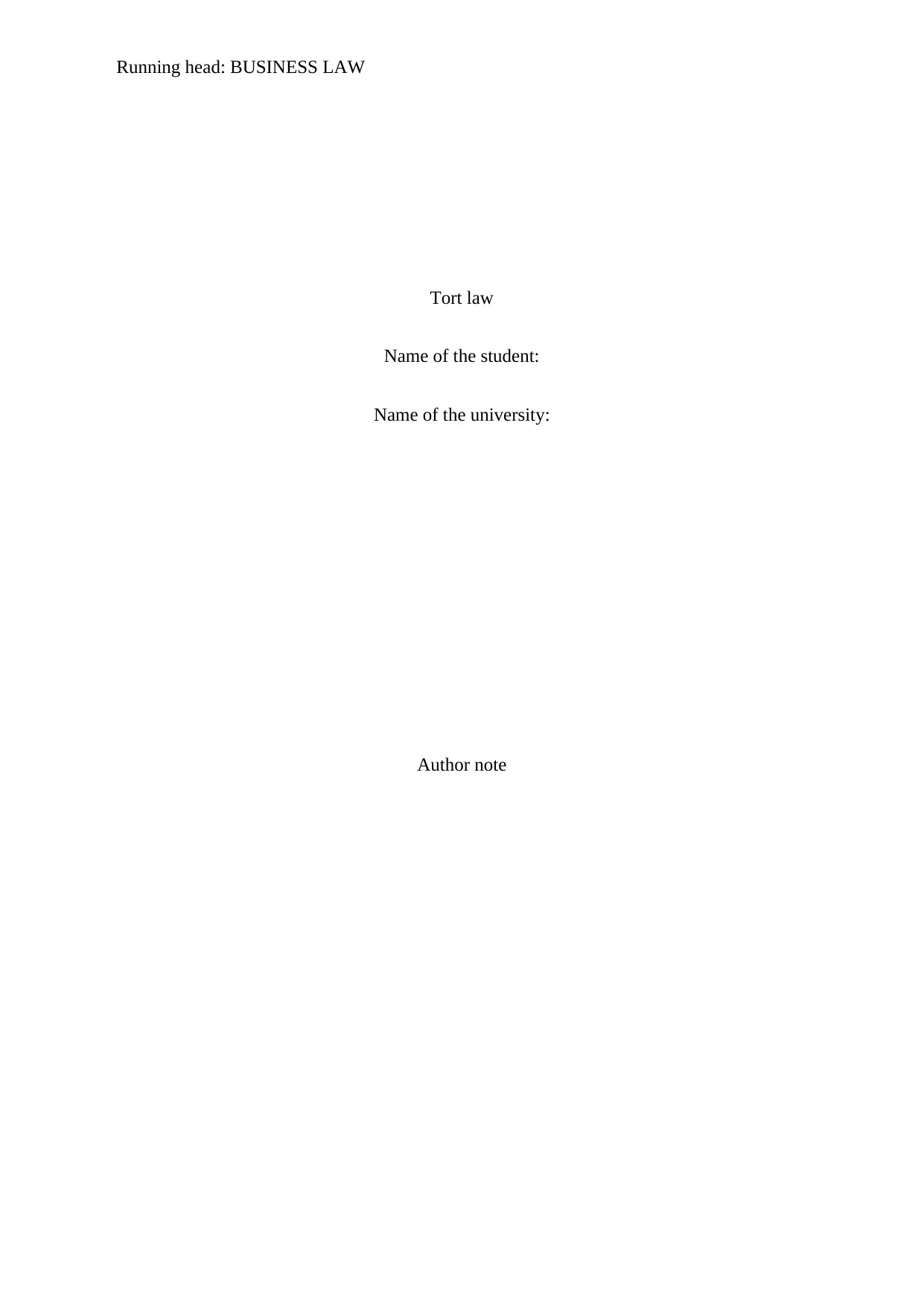
Running head: BUSINESS LAW
Tort law
Name of the student:
Name of the university:
Author note
Tort law
Name of the student:
Name of the university:
Author note
Paraphrase This Document
Need a fresh take? Get an instant paraphrase of this document with our AI Paraphraser
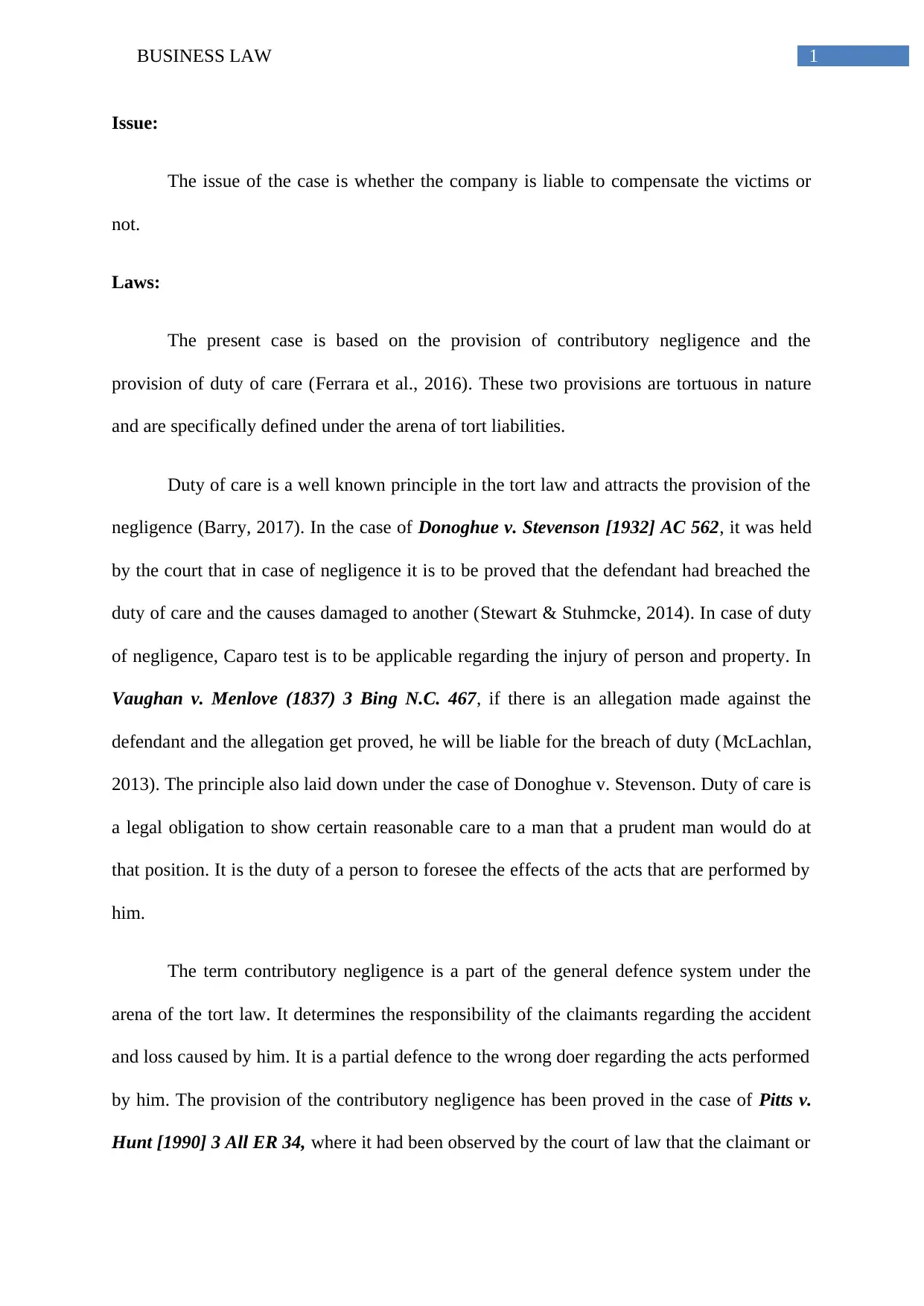
1BUSINESS LAW
Issue:
The issue of the case is whether the company is liable to compensate the victims or
not.
Laws:
The present case is based on the provision of contributory negligence and the
provision of duty of care (Ferrara et al., 2016). These two provisions are tortuous in nature
and are specifically defined under the arena of tort liabilities.
Duty of care is a well known principle in the tort law and attracts the provision of the
negligence (Barry, 2017). In the case of Donoghue v. Stevenson [1932] AC 562, it was held
by the court that in case of negligence it is to be proved that the defendant had breached the
duty of care and the causes damaged to another (Stewart & Stuhmcke, 2014). In case of duty
of negligence, Caparo test is to be applicable regarding the injury of person and property. In
Vaughan v. Menlove (1837) 3 Bing N.C. 467, if there is an allegation made against the
defendant and the allegation get proved, he will be liable for the breach of duty (McLachlan,
2013). The principle also laid down under the case of Donoghue v. Stevenson. Duty of care is
a legal obligation to show certain reasonable care to a man that a prudent man would do at
that position. It is the duty of a person to foresee the effects of the acts that are performed by
him.
The term contributory negligence is a part of the general defence system under the
arena of the tort law. It determines the responsibility of the claimants regarding the accident
and loss caused by him. It is a partial defence to the wrong doer regarding the acts performed
by him. The provision of the contributory negligence has been proved in the case of Pitts v.
Hunt [1990] 3 All ER 34, where it had been observed by the court of law that the claimant or
Issue:
The issue of the case is whether the company is liable to compensate the victims or
not.
Laws:
The present case is based on the provision of contributory negligence and the
provision of duty of care (Ferrara et al., 2016). These two provisions are tortuous in nature
and are specifically defined under the arena of tort liabilities.
Duty of care is a well known principle in the tort law and attracts the provision of the
negligence (Barry, 2017). In the case of Donoghue v. Stevenson [1932] AC 562, it was held
by the court that in case of negligence it is to be proved that the defendant had breached the
duty of care and the causes damaged to another (Stewart & Stuhmcke, 2014). In case of duty
of negligence, Caparo test is to be applicable regarding the injury of person and property. In
Vaughan v. Menlove (1837) 3 Bing N.C. 467, if there is an allegation made against the
defendant and the allegation get proved, he will be liable for the breach of duty (McLachlan,
2013). The principle also laid down under the case of Donoghue v. Stevenson. Duty of care is
a legal obligation to show certain reasonable care to a man that a prudent man would do at
that position. It is the duty of a person to foresee the effects of the acts that are performed by
him.
The term contributory negligence is a part of the general defence system under the
arena of the tort law. It determines the responsibility of the claimants regarding the accident
and loss caused by him. It is a partial defence to the wrong doer regarding the acts performed
by him. The provision of the contributory negligence has been proved in the case of Pitts v.
Hunt [1990] 3 All ER 34, where it had been observed by the court of law that the claimant or
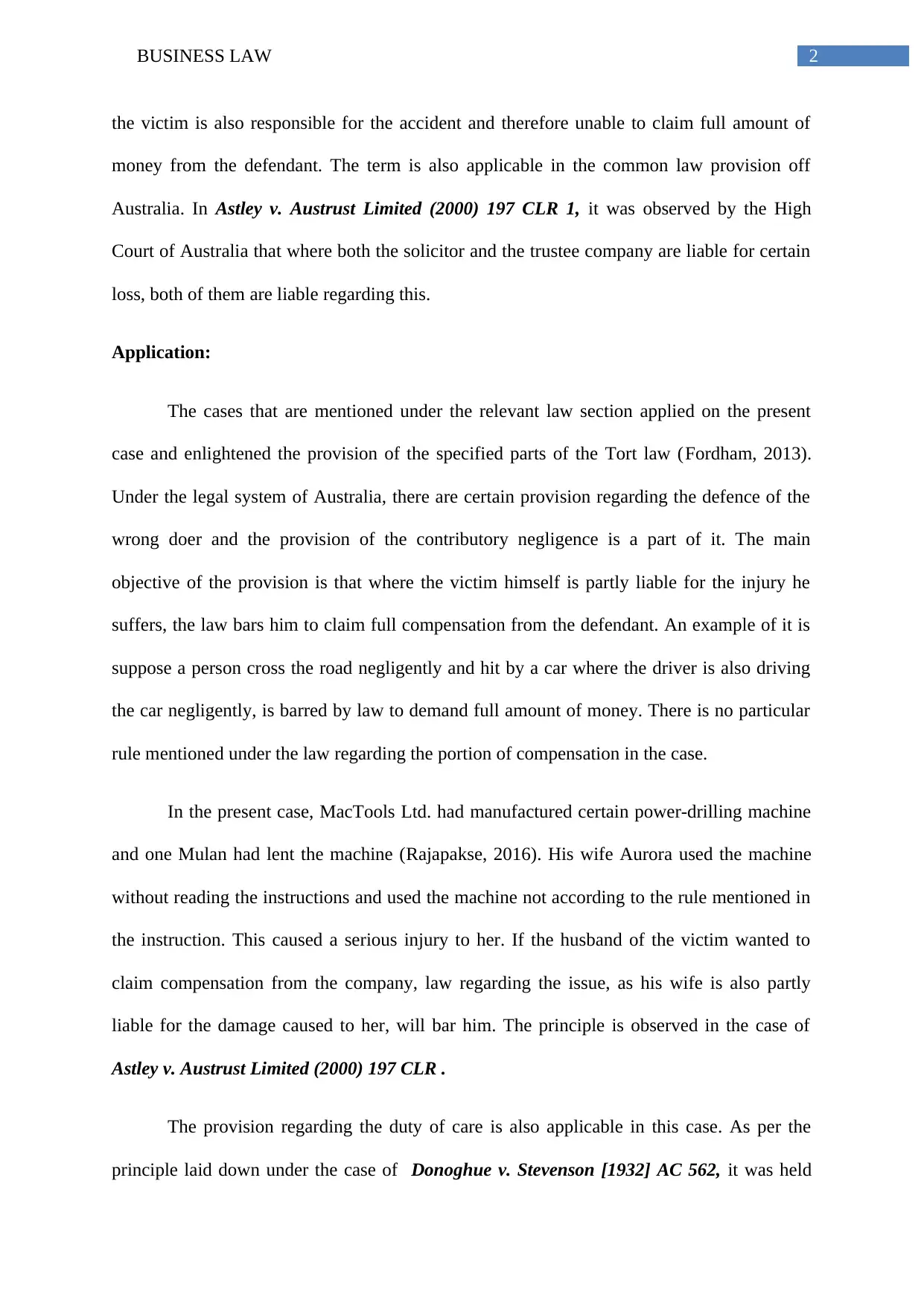
2BUSINESS LAW
the victim is also responsible for the accident and therefore unable to claim full amount of
money from the defendant. The term is also applicable in the common law provision off
Australia. In Astley v. Austrust Limited (2000) 197 CLR 1, it was observed by the High
Court of Australia that where both the solicitor and the trustee company are liable for certain
loss, both of them are liable regarding this.
Application:
The cases that are mentioned under the relevant law section applied on the present
case and enlightened the provision of the specified parts of the Tort law (Fordham, 2013).
Under the legal system of Australia, there are certain provision regarding the defence of the
wrong doer and the provision of the contributory negligence is a part of it. The main
objective of the provision is that where the victim himself is partly liable for the injury he
suffers, the law bars him to claim full compensation from the defendant. An example of it is
suppose a person cross the road negligently and hit by a car where the driver is also driving
the car negligently, is barred by law to demand full amount of money. There is no particular
rule mentioned under the law regarding the portion of compensation in the case.
In the present case, MacTools Ltd. had manufactured certain power-drilling machine
and one Mulan had lent the machine (Rajapakse, 2016). His wife Aurora used the machine
without reading the instructions and used the machine not according to the rule mentioned in
the instruction. This caused a serious injury to her. If the husband of the victim wanted to
claim compensation from the company, law regarding the issue, as his wife is also partly
liable for the damage caused to her, will bar him. The principle is observed in the case of
Astley v. Austrust Limited (2000) 197 CLR .
The provision regarding the duty of care is also applicable in this case. As per the
principle laid down under the case of Donoghue v. Stevenson [1932] AC 562, it was held
the victim is also responsible for the accident and therefore unable to claim full amount of
money from the defendant. The term is also applicable in the common law provision off
Australia. In Astley v. Austrust Limited (2000) 197 CLR 1, it was observed by the High
Court of Australia that where both the solicitor and the trustee company are liable for certain
loss, both of them are liable regarding this.
Application:
The cases that are mentioned under the relevant law section applied on the present
case and enlightened the provision of the specified parts of the Tort law (Fordham, 2013).
Under the legal system of Australia, there are certain provision regarding the defence of the
wrong doer and the provision of the contributory negligence is a part of it. The main
objective of the provision is that where the victim himself is partly liable for the injury he
suffers, the law bars him to claim full compensation from the defendant. An example of it is
suppose a person cross the road negligently and hit by a car where the driver is also driving
the car negligently, is barred by law to demand full amount of money. There is no particular
rule mentioned under the law regarding the portion of compensation in the case.
In the present case, MacTools Ltd. had manufactured certain power-drilling machine
and one Mulan had lent the machine (Rajapakse, 2016). His wife Aurora used the machine
without reading the instructions and used the machine not according to the rule mentioned in
the instruction. This caused a serious injury to her. If the husband of the victim wanted to
claim compensation from the company, law regarding the issue, as his wife is also partly
liable for the damage caused to her, will bar him. The principle is observed in the case of
Astley v. Austrust Limited (2000) 197 CLR .
The provision regarding the duty of care is also applicable in this case. As per the
principle laid down under the case of Donoghue v. Stevenson [1932] AC 562, it was held
⊘ This is a preview!⊘
Do you want full access?
Subscribe today to unlock all pages.

Trusted by 1+ million students worldwide
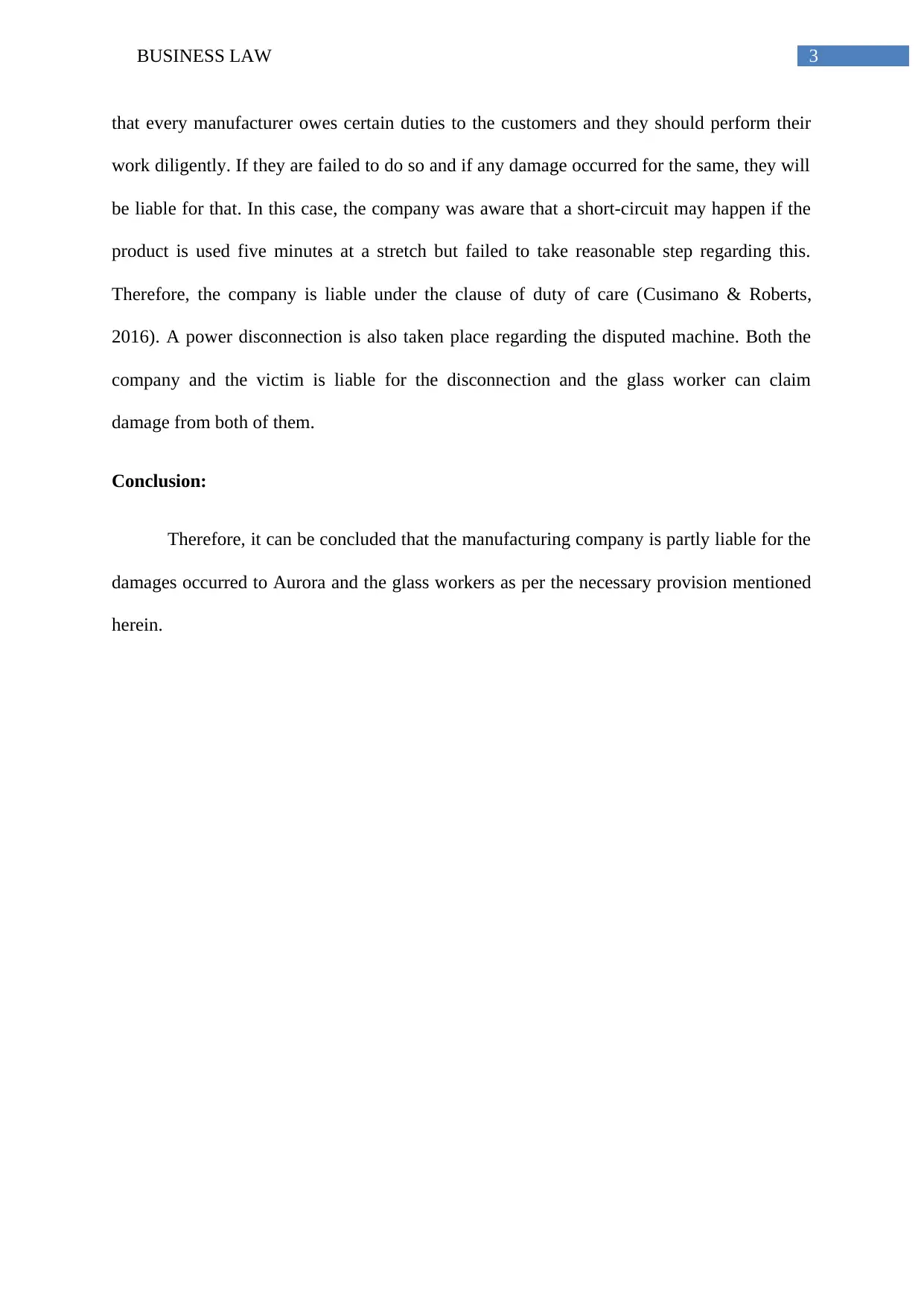
3BUSINESS LAW
that every manufacturer owes certain duties to the customers and they should perform their
work diligently. If they are failed to do so and if any damage occurred for the same, they will
be liable for that. In this case, the company was aware that a short-circuit may happen if the
product is used five minutes at a stretch but failed to take reasonable step regarding this.
Therefore, the company is liable under the clause of duty of care (Cusimano & Roberts,
2016). A power disconnection is also taken place regarding the disputed machine. Both the
company and the victim is liable for the disconnection and the glass worker can claim
damage from both of them.
Conclusion:
Therefore, it can be concluded that the manufacturing company is partly liable for the
damages occurred to Aurora and the glass workers as per the necessary provision mentioned
herein.
that every manufacturer owes certain duties to the customers and they should perform their
work diligently. If they are failed to do so and if any damage occurred for the same, they will
be liable for that. In this case, the company was aware that a short-circuit may happen if the
product is used five minutes at a stretch but failed to take reasonable step regarding this.
Therefore, the company is liable under the clause of duty of care (Cusimano & Roberts,
2016). A power disconnection is also taken place regarding the disputed machine. Both the
company and the victim is liable for the disconnection and the glass worker can claim
damage from both of them.
Conclusion:
Therefore, it can be concluded that the manufacturing company is partly liable for the
damages occurred to Aurora and the glass workers as per the necessary provision mentioned
herein.
Paraphrase This Document
Need a fresh take? Get an instant paraphrase of this document with our AI Paraphraser
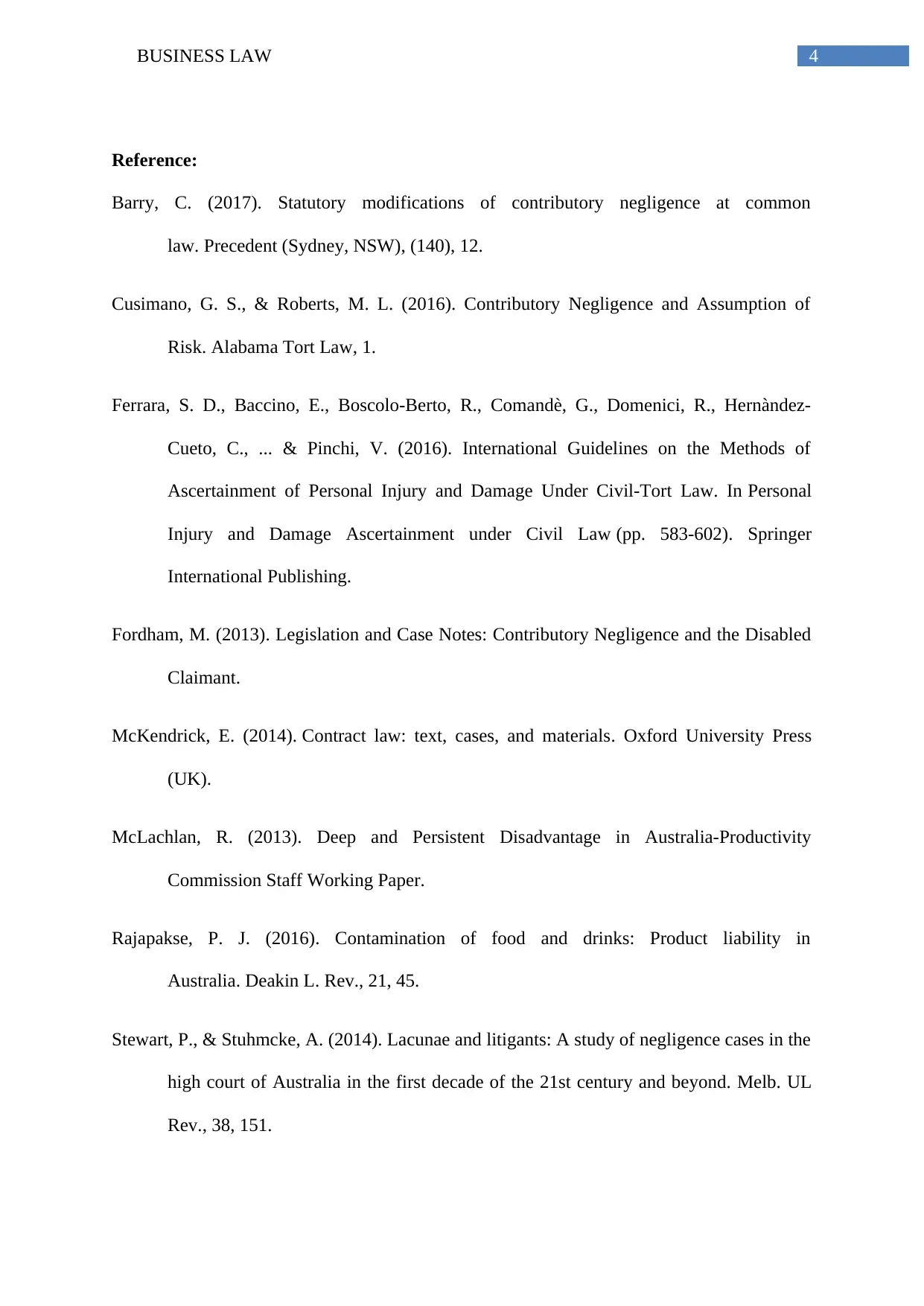
4BUSINESS LAW
Reference:
Barry, C. (2017). Statutory modifications of contributory negligence at common
law. Precedent (Sydney, NSW), (140), 12.
Cusimano, G. S., & Roberts, M. L. (2016). Contributory Negligence and Assumption of
Risk. Alabama Tort Law, 1.
Ferrara, S. D., Baccino, E., Boscolo-Berto, R., Comandè, G., Domenici, R., Hernàndez-
Cueto, C., ... & Pinchi, V. (2016). International Guidelines on the Methods of
Ascertainment of Personal Injury and Damage Under Civil-Tort Law. In Personal
Injury and Damage Ascertainment under Civil Law (pp. 583-602). Springer
International Publishing.
Fordham, M. (2013). Legislation and Case Notes: Contributory Negligence and the Disabled
Claimant.
McKendrick, E. (2014). Contract law: text, cases, and materials. Oxford University Press
(UK).
McLachlan, R. (2013). Deep and Persistent Disadvantage in Australia-Productivity
Commission Staff Working Paper.
Rajapakse, P. J. (2016). Contamination of food and drinks: Product liability in
Australia. Deakin L. Rev., 21, 45.
Stewart, P., & Stuhmcke, A. (2014). Lacunae and litigants: A study of negligence cases in the
high court of Australia in the first decade of the 21st century and beyond. Melb. UL
Rev., 38, 151.
Reference:
Barry, C. (2017). Statutory modifications of contributory negligence at common
law. Precedent (Sydney, NSW), (140), 12.
Cusimano, G. S., & Roberts, M. L. (2016). Contributory Negligence and Assumption of
Risk. Alabama Tort Law, 1.
Ferrara, S. D., Baccino, E., Boscolo-Berto, R., Comandè, G., Domenici, R., Hernàndez-
Cueto, C., ... & Pinchi, V. (2016). International Guidelines on the Methods of
Ascertainment of Personal Injury and Damage Under Civil-Tort Law. In Personal
Injury and Damage Ascertainment under Civil Law (pp. 583-602). Springer
International Publishing.
Fordham, M. (2013). Legislation and Case Notes: Contributory Negligence and the Disabled
Claimant.
McKendrick, E. (2014). Contract law: text, cases, and materials. Oxford University Press
(UK).
McLachlan, R. (2013). Deep and Persistent Disadvantage in Australia-Productivity
Commission Staff Working Paper.
Rajapakse, P. J. (2016). Contamination of food and drinks: Product liability in
Australia. Deakin L. Rev., 21, 45.
Stewart, P., & Stuhmcke, A. (2014). Lacunae and litigants: A study of negligence cases in the
high court of Australia in the first decade of the 21st century and beyond. Melb. UL
Rev., 38, 151.
1 out of 5
Related Documents
Your All-in-One AI-Powered Toolkit for Academic Success.
+13062052269
info@desklib.com
Available 24*7 on WhatsApp / Email
![[object Object]](/_next/static/media/star-bottom.7253800d.svg)
Unlock your academic potential
Copyright © 2020–2025 A2Z Services. All Rights Reserved. Developed and managed by ZUCOL.





